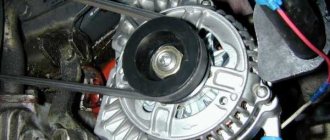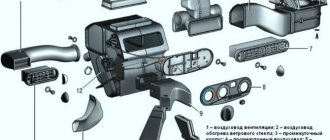About the VAZ 21213/21214 engine for Chevrolet Niva
Engine VAZ 21213 1.7 l.
representative of carburetor/injection engines with timing chain drive. The engine has four cylinders and an overhead camshaft. The basis for the engine installed on the Chevrolet Niva was the 214 engine. However, unlike it, the block was adapted so that it could be installed in the engine compartment of a Chevrolet Niva. However, the differences do not end there. The VAZ 21213 is distinguished by, among other things, a different cylinder diameter and cylinder head. The engine block itself is lower in comparison, for example, with the 2106 engine. The positive aspects of the engine include the fact that it has a chain tensioner. Thus, the owner is spared the need to tighten the chain. There is no need to adjust the valves either, since there are hydraulic compensators. If we talk about the shortcomings, we have to note the fact that the engine is quite noisy. In addition, the engine is characterized by increased oil consumption. Significant vibrations often occur during engine operation. Finally, the engine has a rather low resource and is prone to overheating. In general, the engine is characterized by most of the shortcomings that other representatives of this series have. Therefore, extraneous knocks, engine vibrations, and the risk of overheating will cause inconvenience to the owner. There is no need to dwell especially on the issue of Chevrolet Niva chip tuning. The fact is that using a chip will give practically nothing to an atmospheric engine. And therefore this matter is empty. However, almost every car owner has a desire to add power to the engine. So let's think about what can be done. First of all, an increase in the piston stroke should be achieved through the use of a VAZ 2130 crankshaft and eighty-two millimeter pistons (the piston pin is shifted by two millimeters). Next, you will need to bore the cylinders for an 84 mm piston. In addition, you will need a higher-performance carburetor, boring of the cylinder head channels, and lightweight connecting rods. After all the procedures, it will be possible to achieve approximately 100 hp. We can go further. To do this, you will need to purchase a tuning crankshaft and install a “Nuzhdin” camshaft or similar. You will also need lightweight connecting rods and a flywheel, as well as a modified carburetor. The result is approximately 110 hp. In addition, you can try using a turbine or compressor on the engine. True, you need to be prepared for the fact that such a modification may slightly reduce the resource.
Source
Maintenance
The manufacturer AvtoVAZ recommends servicing the 21214 engine on your own or at a service station according to the following schedule:
- the oil and filter are updated annually or after 7.5 - 10 thousand mileage;
- the chain has a high resource of 200 thousand, but is regularly monitored for stretching/tension;
- the fuel and air filters become unusable after 20 - 30 thousand mileage;
- spark plugs and batteries are usually enough for 60 - 70 thousand km;
- It is recommended to update the cabin filter annually, regardless of the car's mileage.
Also interesting: Amount of oils and fuel fluids VAZ 4×4 2121 Niva
Initially, the internal combustion engine design was simpler, but it was necessary to periodically adjust the erroneous settings of the valve thermal clearances. Then the modernization added hydraulic pushers to the timing belt design, saving the user from this operation and monthly expenses.
Read news about the new Niva
- Tire size for the field, all-season tires for the field 4×4, mud tires, the best winter tires for wheels r16 "
- We change hydraulic compensators on a Chevrolet Niva with our own hands
- Niva Chevrolet front wheel bearings
- Make your own music — — LiveJournal
- Which is better Chevrolet Niva or VAZ Niva 2131
- Installation of a removable winch on Niva 2121
- Rear disc brakes on Niva 2121 instead of standard drum brakes || Strengthened brakes on a Chevrolet Niva
- Connecting the Chevrolet Niva towbar socket: trailer connection diagram, pinout, how to connect it yourself
Niva engine
Below is a list with a detailed description of the characteristics installed on the Niva with an index starting with 2121 and onwards. All Niva engines have an 8-valve engine with chain timing drive.
Engine 2121
The Niva got this internal combustion engine from the VAZ 2106, but, of course, it was modernized. Its volume was increased to 1.6 liters, which made it possible to remove a large amount of horsepower from the engine, which is so necessary for all-wheel drive. The engine was equipped with a two-chamber carburetor of increased volume, which also had a positive effect on the technical characteristics of the car. This engine was installed virtually unchanged until 2005; in 1995, the internal combustion engine underwent minor modifications, and its volume increased to 1.7 liters.
Specifications
| 1.6 liters until 1995 | 1.7 liters after 1995 to 2005 | |
| Type | Petrol | Petrol |
| Volume (cm 3 ) | 1580 | 1696 |
| Power (hp) | 80 | 81 |
| Torque (Nm) | 116 | 129 |
| timing belt | Chain | Chain |
| Cooling | Liquid | Liquid |
| Number of valves | 8 | 8 |
| Number of cylinders | 4 | 4 |
| Supply system | Carburetor | Carburetor |
| Max. Speed (km/h) | 130 | 134 |
| Fuel consumption | 10,8 | 11,2 |
Engine 21214
In 2005, the Volga Automobile Plant, due to the introduction of EURO standards, switched to injection engines. This engine has an index of 21214 with an engine capacity of 1.7 liters and fuel injection using the distribution method through nozzles. This engine turned out to be quite successful and literally took the Niva to a new level. The injector made it possible to achieve more pleasant engine operation, easier starting and fuel economy. The engine continues to be produced to this day on Niva Urban and Niva 4x4 vehicles.
Specifications
| Type | Petrol |
| Volume (cm 3 ) | 1696 |
| Power (hp) | 83 |
| Torque (Nm) | 127,5 |
| timing belt | Chain |
| Cooling | Liquid |
| Number of valves | 8 |
| Number of cylinders | 4 |
| Supply system | Injector |
| Max. Speed (km/h) | 134 |
| Fuel consumption | 9,1 |
Niva Chevrolet
This car appeared in the alliance of the Volga plant and General Motors in 1998 and made a lot of noise. Russian SUV with a modern design, all-wheel drive, transfer case and locking. The car was produced since 1998, and in 2009 it received an updated design, in which it is produced to this day.
This Niva model was equipped with domestically produced engines and. ICEs differed in engine size and power; it is quite rare to find an imported engine in a Chevy, but they do occur.
Engine 2123
A domestically produced internal combustion engine designed specifically for the Chevrolet Niva. Its differences lay in adaptation and adaptation to the new engine compartment, into which the new engine could easily fit. By the way, I had to give up the spare tire under the hood and hang it on the back door.
Specifications
| Type | Petrol |
| Volume (cm 3 ) | 1690 |
| Power (hp) | 80 |
| Torque (Nm) | 128 |
| timing belt | Chain |
| Cooling | Liquid |
| Number of valves | 8 |
| Number of cylinders | 4 |
| Supply system | Injector |
| Max. Speed (km/h) | 140 |
| Fuel consumption | 10,9 |
Engine Z18XE
This engine is a development by OPEL. With the transition to this internal combustion engine, due to increased torque and greater power, the transfer case had to be redesigned, namely, the additional ratios had to be changed. The Z18XE engine turned out to be more dynamic and powerful, which had a positive effect on the driving characteristics of the car. This is the first Niva engine with 4 valves per cylinder.
Specifications
Source
Chevrolet Niva engines
According to the Chevrolet Niva classification, it is classified as a compact all-terrain vehicle. Excellent technical characteristics allow you to operate the car in almost any, even the most severe conditions. Therefore, the model has become so popular in our country. Let's look at the features of this vehicle, as well as all the engine models that were installed on the car.
Model
The new model was first shown at the Moscow Motor Show in 1998, and it was assumed that the series launch would occur in the same year. But the crisis did not allow the manufacturer to start production. As a result, small-scale assembly began only in 2001, and full-scale production began in 2002, having organized a joint venture with General Motors.
Initially it was assumed that this model would replace the regular Niva, but in the end both models began to be produced in parallel. Moreover, Chevrolet Niva occupied the more expensive segment.
Produced all the time at the plant in Togliatti. This is the base site of AvtoVAZ. Most of the components are produced here. Only the Z18XE engine used in the pre-restyling version of the car was imported from abroad. Used only until 2009. This engine was produced at the Szentgotthard engine plant.
Features of operation
To ensure long-term and trouble-free operation of the power unit, it must be very carefully and properly maintained. It is also recommended not to allow the engine to operate in extreme modes.
First, let's look at the VAZ-2123 engine, it is a modified version of the power unit installed on the “classic Niva”. The main differences are as follows.
The Z18XE engine was widely used in various car models. There are several modifications of the power unit. Installed on the Chevrolet Niva, it had the following features.
The result was an original motor with interesting settings. Thanks to the settings, it is possible to achieve some variation in power and throttle response.
Service
To achieve maximum service life, it is important to properly maintain the motor. First of all, it is worth remembering the importance of timely replacement of engine oil. It is recommended to carry out this work once every 15 thousand kilometers. Every second replacement should be combined with washing. This recommendation applies to both engines.
It is also worth choosing the right oil. The Z18XE engine should only be filled with synthetics; the best options would be:
It will require approximately 4.5 liters.
The VAZ-2123 engine is filled with 3.75 liters of lubricant; here it would also be optimal to use synthetics. For other parameters, you can use the same oil as for the engine described above.
The VAZ-2123 engine has a timing chain drive. In this regard, it is changed quite rarely. The average service life between replacements is 150 thousand kilometers. At the same time, the manufacturer does not regulate the time of replacement. Everything is determined by the signs of a problem, first of all we are talking about increased engine noise, especially when picking up or dropping speed.
The Z18XE motor is belt driven. According to the manufacturer's specifications, it must be replaced at 60 thousand kilometers. And according to the experience of car enthusiasts, it is better to do this after 45-50 thousand, as there is a risk of breakage. In this case, you will get bent valves.
Malfunctions
Quite often, drivers complain about the quality and reliability of the Chevrolet Niva internal combustion engine. In fact, there are quite a few problems here, and first of all we are talking about technical shortcomings. It was previously mentioned that drivers may experience a broken belt on the Z18XE, and in this case, there will be bent valves. This clearly leads to the need for major repairs.
The timing chain drive, which is equipped with the domestic power unit, can also create problems. There is a hydraulic tensioner installed there; it can fail already at a mileage of 50 thousand. If you do not pay attention to this in a timely manner, the chain jumps. Accordingly, we get damaged valves.
Also on the VAZ-2123, hydraulic compensators may fail. This leads to valve knocking and increased fuel consumption. Another standard problem for Russian engines is constant leaks. Oil can escape from under any gaskets, which is not very good.
Both engines have a common problem with the ignition modules. They often fail at a mileage of 100-120 thousand. The first sign of a breakdown can be called engine tripping.
The Z18XE engine is characterized by a failure of the control unit. Often in this case a number of problems arise in the operation of the motor. Moreover, the ECU may generate errors from different sensors, and they will change after each reset. Inexperienced mechanics often go through the entire engine until they get to the true cause of the breakdown. Floating speeds may also occur, especially at low speeds, the reason is contamination of the throttle valve.
Swap
One of the popular types of tuning is SWAP. In this case, the motor with poor performance is simply replaced with another, more suitable one. There are many options for such modification. First of all, you should decide what you need and what engine is standard. If you have a VAZ engine installed, you can try installing a Z18XE, in this case you will get an increase of almost 40 hp. and you won't have to redo anything at all. Well, if only the gearbox is changed.
Another interesting thing: the Niva’s engine does not start. What to do?
Also, quite often, drivers install the VAZ 21126, which is standardly intended for the Priora. As a result, you will get a longer resource, as well as slightly increased power. To install, you will need to modify the exhaust manifold; it is placed on a thick gasket of 2-3 cm, then the pants will not come into contact with the spar.
Few people know that it was planned to release a diesel version of the Chevrolet Niva. It was supposed to use an engine manufactured by Peugeot - XUD 9 SD. It is almost ideal for Shniva. To install it, no modifications are required at all, only flashing the ECU, after all, the engine is diesel.
For cars with Z18XE, the same recommendations are suitable as for the VAZ unit. The only caveat is turbocharging. The fact is that this engine was originally intended and used for Opel. For German cars there was an option with a turbine. So you can install it, increasing engine power and throttle response. No modifications other than additional tuning of the ECU will be required.
Which modification is better
It is impossible to say unequivocally which engine is more reliable and better. A lot depends on how you use the car. For urban conditions, the Z18XE is better suited; it is more effective on asphalt. The VAZ-2123 has lower revs, which is very good off-road.
If we take reliability into account, both cars break down. But the Z18XE has much fewer minor faults that ruin the lives of car enthusiasts. At the same time, the VAZ-2123 is well known for minor problems with leaks, sensor failures and other shortcomings.
Source
Why do they find out the environmental class?
Of course, for those who prefer buying cars in dealerships or used cars in Russia, it is not necessary to find out the nuances of this class. If there is a certain model on the market, you can be sure that the car has been cleared by customs and you can register it.
If a citizen or company wants to buy a car abroad, go through customs control without outside help, pay a duty, register a car, determining the environmental class plays an important role.
Source
Engine on a Chevrolet Niva: characteristics, repair and tuning
Cars of the Chevrolet Niva model received the VAZ-2123 engine, which is quite powerful for this type of car, the main design features of which are a 4-cylinder vertical mechanism. The Chevrolet Niva engine has a built-in fuel injection control system and also complies with European Euro 2 standards for toxic emissions.
Comparing the new modification of the VAZ-2123 with previous analogues, one immediately notices one of the main advantages for the motorist - reduced noise level. This result was achieved thanks to the use of hydraulic chain tensioners, as well as a single-row chain device.
The reason for the reduced noise production is the presence of a hydraulic support for the valves. This engine has one more difference from previous models of this engine - the ability to install knock sensors on the cylinder blocks, which is provided by the bosses.
Technical characteristics of VAZ-2123
| OPTIONS | MEANING |
| Brand | Engine VAZ-2123 |
| Type | Powered by gasoline, has 4 cylinders, electronically controlled fuel injection volume control system |
| Power | Up to 80 hp |
| Maximum engine capacity | 1690 cm 3 |
| Gas tank capacity | Up to 58 l |
| Highest developed speed | 140 km/h |
| Achievable torque | 127.5 Nm |
| Average gasoline consumption per 100 km. mileage: | |
| when driving outside the city | Up to 8.8 l |
| in urban environments | Up to 14.1 l |
| with variable driving in different conditions | Up to 10.8 l |
| Maximum compression level | 9.3 atm. |
| Diameter of one cylinder | 82 mm |
| Number of valves used in the device | 8 |
| Minimum crankshaft speed | 750 rpm |
| Weight of the entire structure | 127 kg |
This motor can be installed on Chevrolet Niva, Niva 21213 and 21214 models.
A few words about the standard engine
The modernized engine received the index 2123, it was changed only because of the engine compartment, but everything remained from the old engine and is easily interchangeable with 21214. Its production began in 1994, the block is made of cast iron. The head has two valves per cylinder, the pistons were installed with a diameter of 82 mm, and their stroke remained the same and equal to 80 mm. The increased diameter of the piston made it possible to increase, albeit slightly, its power; it became equal to 81 hp, with a compression ratio of approximately 9.4.
When operating at a speed of approximately 3,000 per minute, the maximum possible torque of 125 NxM is obtained. The fuel recommended by the plant is AI 93 gasoline, but its appetite is somewhat voracious, ranging from 10 to 12 liters per 100 km. mileage Its mass is 117 kg. The design provides for an overhead camshaft and a timing chain drive.
In the new Niva, they changed the method of installing the unit in the engine compartment, as well as the location and fastening of attachments. As an advantage, we can note the installation of hydraulic compensators for valves and a chain tensioner. Disadvantages include noise and slight vibration of the engine. Manufacturers claim its resource is approximately 80,000 km. mileage, but practically it is much higher and can reach up to 200 thousand.
Design features of the VAZ-2123 engine
Otherwise, all components remain the same and do not differ from previous models, such as 21214. This can be judged based on the installation of a spring-hydraulic system, which has been used in VAZ mechanisms for many years.
The water pump as well as the generator are driven by interaction with a pulley mounted on the crankshaft and driving the above-mentioned devices using a serpentine belt.
The standard belt used in the Chevy Niva engine is called “GATES” and serial number 58436 5РК1888.
One of the most noticeable changes in the new engine includes a redesigned engine compartment and a redesigned axle beam. The change in shape occurred due to a design feature - the lack of fastening of the front axle gearbox directly to the engine.
Therefore, this Niva sample is incompatible with engine parts and fasteners from earlier cars from this manufacturer.
Air intake system on VAZ-2123
The new Chevrolet Niva car has a completely new air intake system. The main difference is a significant increase in the volume of the air filter, which can be seen in the significantly larger body.
Elements such as the receiver, intake pipes and the pipe, replaced with a throttle version, were also structurally changed.
The electronic component of the car has also undergone changes. The main control of the motor is carried out thanks to the BOSCH controller, sample MP 7.9.7. In some individual copies, the “January” 7.2 system was also installed.
This not only affects the user-friendly interface, but also allows you to control fuel consumption due to an improved injection control system, which has a pair-parallel design. Thus, this machine has the ability to comply with Euro-2 standards.
To reduce the emission of harmful substances from a car, you can install a phased gasoline injection system, which will help raise the safety bar to the Euro-3 level and at the same time optimize the use of fuel due to its more accurate supply.
Other changes related to the operation of the Chevrolet Niva engine include:
Why are environmental classes necessary?
In just one year, just one ordinary car absorbs over 4,000 kg of oxygen contained in the atmosphere. And as a result of processing this oxygen, the engine emits about 800 kg of carbon monoxide, 200 kg of carbon, and 40 g of nitric oxide.
Since the number of cars increases every year, the state of the environment throughout the world in general and in each specific large city is quite deplorable. Environmental communities have been talking about this for a long time, but banning cars is hardly possible in principle.
For this reason, today cars are divided into environmental classes and are required to meet the standards of automakers. These classes mean a certain gradation of cars into categories, taking into account toxic substances that contain exhaust gases and evaporating fuel, for a specific make and model. Carbon monoxide, nitric oxide, heavy metals, and hydrocarbons pose a danger to humans and nature.
An example of car exhaust gases that violate Russian eco-standards
Malfunctions of VAZ-2123
| Causes | How to fix |
| Engine won't start | |
| There are several main reasons for problems with starting the Chevrolet Niva VAZ-2123 engine: 1. Severe contamination of the fuel line, which caused insufficient fuel to enter the engine; 2. The filter in the connection between the gasoline supply pipe and the engine has not been replaced for a long time; 3. Problem with the feed pump (does not pump, does not pump enough fuel). | Basically, you can fix the problem yourself: 1. To prevent clogging of the fuel system, you need to rinse with water or blow with compressed air; 2. Repair or replace the fuel injection unit; 3. Clean or change the filter. |
| Constantly stalls while driving or idling | |
| 1. Lack of the required level of pressure in the gasoline supply system (also true for a field with a diesel engine); 2. Problems with the idle control device; 3. Air getting into the fuel supply hoses, unstable operation of the crankcase ventilation, air getting into the brake boosters, which should be sealed by default. | 1. Check the serviceability of the pump, repair or replace it with a new one; 2. It is quite difficult to repair the idle air control yourself, so an easier solution would be to completely replace it with a new one; 3. If air is trapped in places where it should not be, it is worth checking all the clamps, tightening them, and making sure that there are no damaged hoses and fasteners. |
| Engine power is not rated | |
| 1. Problem with the throttle valve, its incomplete opening; 2. Also, due to a malfunction of the electronic component, namely the throttle position sensor, problems may arise with supplying the required amount of gasoline to the engine; 3. Inoperative or faulty ignition system in the car. | 1. Carry out diagnostics and adjustment of the throttle. To do this, you do not need to have any special skills, which allows any car enthusiast to cope with the task; 2. If there are problems with electronic sensors, the best solution is to completely replace them; 3. Check the serviceability of the spark plugs and the presence of a working battery. |
Tuning the VAZ-2123 engine
There are several basic ways that, with the help of small changes in the design of the engine, can change its characteristics and increase power.
But you should not expect any high results due to the design features of the mechanism produced by a domestic manufacturer.
Therefore, immediately before attempting to modify the VAZ-2123, it is worth weighing the pros and cons.
Still, there are several ways to slightly optimize the operation of this sample Chevy Niva engine:
You can also completely replace the exhaust system, while increasing the diameter of the exhaust pipes, and replace the catalyst with a flame arrester.
Important! These changes to the engine entail the need to reconfigure the operation of the fuel supply system, since with standard configurations and an increased volume, the fuel supplied to the cylinders will not be enough. That is, you will need to perform chip tuning.
Thanks to the work performed, power increases by 15%, which also leads to an increase in fuel consumption.
Reprogramming the electronic control unit
The most common method of engine modification is chip tuning. The undoubted advantage of this method is that it does not require significant capital investments, but at the same time it is quite effective. This is due to the fact that chip tuning does not provide for design modernization of the engine.
The essence of chip tuning lies in making changes to the existing ECU system, adjusting the entire fuel supply complex. By changing the properties of the power unit, you can achieve both a reduction in fuel consumption and an increase in power. But at the same time, it is possible to install such software in which a balance will be maintained between consumption and engine operation.
With proper work with the software, you can achieve successful optimization of engine operation, namely setting it to 110-120 hp. at the same fuel consumption.











